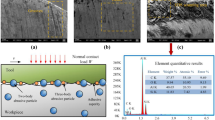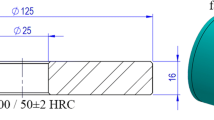Abstract
In this work, a geometrical model is established to calculate the wear volume of cutting tool, into which the effects of rake angle, clearance angle, and tool nose radius are successfully integrated. And then the dynamic tool wear process is investigated based on the precision turning of 45 vol%SiCp/2024Al with PolyCrystalline Diamond (PCD) tools. A new evaluation parameter, i.e., tool wear volume rate, is defined to compare the wear resistance of tools with varied geometrical parameters. Experimental results show that tool wear volume rate is closely related to the grain size of PCD and tool rake angle. However, it is independent on tool nose radius. Subsequently, the prediction model of tool wear volume as a function of cutting length is further formulated to characterize the dynamic evolution of tool wear. The validation experiments show that the prediction accuracy is satisfactory, i.e., that the average prediction error is only 6.13%, which indicates that the calculation method and prediction model of tool wear volume proposed in this work are effective. Finally, the application scope of the developed prediction model is further specified.
Similar content being viewed by others
References
Ge Y, Xu J, Yang H (2010) Diamond tools wear and their applicability when ultra-precision turning of SiCp/2009Al matrix composite. Wear 269(11–12):699–708
Dong G, Zhang H, Zhou M, Zhang Y (2013) Experimental investigation on ultrasonic vibration-assisted turning of SiCp/Al composites. Mater Manuf Process 28(9):999–1002
Kanta Das D, Mishra PC, Singh S, Thakur RK (2015) Tool wear in turning ceramic reinforced aluminum matrix composites--a review. J Compos Mater 49(24):2949–2961
Jaffery SI, Mativenga PT (2009) Study of the use of wear maps for assessing machining performance. Proc Inst Mech Eng B J Eng Manuf 223(9):1097–1105
Zhuang K, Zhu D, Zhang X, Ding H (2014) Notch wear prediction model in turning of Inconel 718 with ceramic tools considering the influence of work hardened layer. Wear 313(1–2):63–74
Ramírez F, Soldani X, Loya J, Miguélez H (2017) A new approach for time-space wear modeling applied to machining tool wear. Wear 390-391:125–134
Rathod KB, Lalwani DI (2018) Modeling of flank wear progression for coated cubic boron nitride tool during hard turning of AISI H11 steel. Mater Today 5(2):6692–6701
Choudhury SK, Srinivas P (2004) Tool wear prediction in turning. J Mater Process Technol 153(1):276–280
Wang C, Ming W, Chen M (2016) Milling tool's flank wear prediction by temperature dependent wear mechanism determination when machining Inconel 182 overlays. Tribol Int 104:140–156
Usui E, Shirakashi T, Kitagawa T (1984) Analytical prediction of cutting tool Wear. Wear 100(1–3):129–151
Attanasio A, Ceretti E, Fiorentino A, Cappellini C, Giardini C (2010) Investigation and FEM-based simulation of tool wear in turning operations with uncoated carbide tools. Wear 269(5–6):344–350
Hosseinkhani K, Ng E (2015) A combined empirical and numerical approach for tool wear prediction in machining. Procedia CIRP 31:304–309
Klocke F, Frank P (2006) Simulation of tool Wear in hard turning. Proceeding of the 9th CIRP international workshop on modeling of machining operations, Bled (Slovenia): 499–508
Rizzuti S, Umbrello D, Outeiro J C, Saoubi R M (2007) Modelling and validation of tool wear during hard machining of AISI H13 tool steel. 10th CIRP international workshop on modeling of machining operations, Reggio Calabria, Italy: 293–300
Binder M, Klocke F, Doebbeler B (2017) An advanced numerical approach on tool wear simulation for tool and process design in metal cutting. Simul Model Pract Theory 70:65–82
Huang Y, Liang SY (2004) Modeling of CBN tool flank wear progression in finish hard turning. J Manuf Sci Eng 126(1):98–106
Rabinowicz E, Dunn LA, Russell PG (1961) A study of abrasive wear under three-body conditions. Wear 4(5):345–355
Zhang G, To S (2016) An in-process tool wear evaluation approach for ultra-precision fly cutting. Int J Adv Manuf Technol 86(1–4):169–177
Rizal M, Ghani JA, Nuawi MZ, Haron CHC (2017) Cutting tool wear classification and detection using multi-sensor signals and Mahalanobis-Taguchi system. Wear 376-377:1759–1765
Tool-Life Testing with Single-Point Turning Tools (1993) International standards, ISO 3685-1993(E). International Organization for Standardization, Geneva
Grzesik W (2016) Advanced machining processes of metallic materials: theory, modelling, and applications, Elsevier, pp 229
Lim SC, Liu YB, Lee SH, Seah KHW (1993) Mapping the wear of some cutting-tool materials. Wear 162-164:971–974
Singh D, Rao PV (2010) Flank wear prediction of ceramic tools in hard turning. Int J Adv Manuf Technol 50(5–8):479–493
Chinchanikar S, Choudhury SK (2015) Predictive modeling for flank wear progression of coated carbide tool in turning hardened steel under practical machining conditions. Int J Adv Manuf Technol 76(5–8):1185–1201
Čerče L, Pušavec F, Kopač J (2015) 3D cutting tool-wear monitoring in the process. J Mech Sci Technol 29(9):3885–3895
Čerče L, Pušavec F, Kopač J (2015) Novel spatial cutting tool-wear measurement system development and its evaluation. Procedia CIRP 37:170–175
Durazo-Cardenas I, Shore P, Luo X, Jacklin T, Impey SA, Cox A (2007) 3D characterization of tool wear whilst diamond turning silicon. Wear 262(3–4):340–349
Kishawy HA, Kannan S, Balazinski M (2005) Analytical modeling of tool wear progression during turning particulate reinforced metal matrix composites. CIRP Ann 54(1):55–58
Kannan S, Kishawy HA, Balazinski M (2006) Flank wear progression during machining metal matrix composites. J Manuf Sci Eng 128(3):787
Narahari P, Pai BC, Pillai RM (1999) Some aspects of machining cast Al-SiCp composites with conventional high speed steel and tungsten carbide tools. J Mater Eng Perform 8(5):538–542
Rajmohan T, Palanikumar K (2013) Application of the central composite design in optimization of machining parameters in drilling hybrid metal matrix composites. Measurement 46(4):1470–1481
Ding X, Liew WYH, Liu XD (2005) Evaluation of machining performance of mmc with PCBN and PCD tools. Wear 259(7–12):1225–1234
Lucchini E, Casto SL, Sbaizero O (2003) The performance of molybdenum toughened alumina cutting tools in turning a particulate metal matrix composite. Mater Sci Eng A 357(1–2):369–375
Xiang J, Xie L, Gao F, Yi J, Pang S, Wang X (2017) Diamond tools wear in drilling of SiCp/Al matrix composites containing copper. Ceram Int 44(5):5341–5351
Arrazola PJ, Özel T, Umbrello D, Davies M, Jawahir IS (2013) Recent advances in modelling of metal machining processes. CIRP Ann 62(2):695–718
Hung NP, Boey FYC, Khor KA, Phua YS, Lee HF (1996) Machinability of aluminum alloys reinforced with silicon carbide particulates. J Mater Process Technol 56(1–4):966–977
Zong W, Sun T, Li D, Cheng K, Liang Y (2008) XPS analysis of the groove wearing marks on flank face of diamond tool in nanometric cutting of silicon wafer. Int J Mach Tools Manuf 48(15):1678–1687
Chan KC, Cheung CF, Ramesh MV, Lee WB, To S (2001) A theoretical and experimental investigation of surface generation in diamond turning of an Al6061/SiCp metal matrix composite. Int J Mech Sci 43(9):2047–2068
Gunay M, Ihsan K, Aslan E, Şeker U (2005) Experimental investigation of the effect of cutting tool rake angle on main cutting force. J Mater Process Technol 166(1):44–49
Gunay M, Aslan E, Ihsan K, Şeker U (2004) Investigation of the effect of rake angle on main cutting force. Int J Mach Tools Manuf 44(9):953–959
Saglam H, Unsacar F, Yaldiz S (2006) Investigation of the effect of rake angle and approaching angle on main cutting force and tool tip temperature. Int J Mach Tools Manuf 46(2):132–141
He C, Zong W, Cao Z, Sun T (2015) Theoretical and empirical coupled modeling on the surface roughness in diamond turning. Mater Des 82:216–222
Funding
The authors would like to thank the Natural Science Foundation of China (No. 51675133) and the Fundamental Research Funds for the Central Universities (No. HIT. BRETIII.201412) for the support of this work. Furthermore, the material is provided by Institute of Metal Matrix Composite Science and Engineering, Harbin Institute of Technology.
Author information
Authors and Affiliations
Corresponding author
Rights and permissions
About this article
Cite this article
Liu, H.Z., Zong, W.J. Prediction model of tool wear volume in precision turning of ceramic particle reinforced aluminum matrix composites. Int J Adv Manuf Technol 100, 2689–2700 (2019). https://doi.org/10.1007/s00170-018-2853-5
Received:
Accepted:
Published:
Issue Date:
DOI: https://doi.org/10.1007/s00170-018-2853-5




